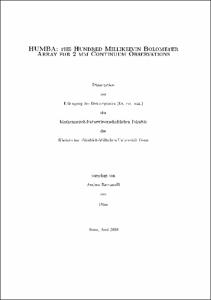Raccanelli, Andrea: HUMBA: the Hundred Millikelvin Bolometer Array for 2 mm Continuum Observations. - Bonn, 2003. - Dissertation, Rheinische Friedrich-Wilhelms-Universität Bonn.
Online-Ausgabe in bonndoc: https://nbn-resolving.org/urn:nbn:de:hbz:5n-02706
Online-Ausgabe in bonndoc: https://nbn-resolving.org/urn:nbn:de:hbz:5n-02706
@phdthesis{handle:20.500.11811/1937,
urn: https://nbn-resolving.org/urn:nbn:de:hbz:5n-02706,
author = {{Andrea Raccanelli}},
title = {HUMBA: the Hundred Millikelvin Bolometer Array for 2 mm Continuum Observations},
school = {Rheinische Friedrich-Wilhelms-Universität Bonn},
year = 2003,
note = {High resolution maps of the Sunyaev-Zel'dovich effect in clusters of galaxies offer a powerful tool for studying physics in clusters and cosmology. The Hundred Millikelvin Bolometer Array (HUMBA) for 2 mm continuum observation is a unique instrument devoted to the observations of the thermal Sunyaev-Zeldovich effect. I report on my work on this instrument and on the results of test observations in November 2001 at the IRAM 30 m telescope.
The performance of HUMBA was seriously limited by an excess of low-frequency noise in the detectors. The source of this noise was investigated and found to originate in the continuously filled 1 K pot of the dilution unit. The noise could be eliminated by converting the helium coming from the main bath to its superfluid state before injecting it into the 1 K pot. The thermalization of the helium to the pot temperature is provided by a heat exchanger internal to the pot. The improvement to the dilution unit has been covered by a patent application.
After being tested with new detectors, HUMBA was installed at the IRAM 30 m telescope. During two days of tests on the sky, we observed the three bright, compact clusters of galaxies RXC J2228.6+2036, RXC J1023.6+0411, and RXC J1401.0+0252 and detected a SZ signal from two of them. Other objects, including the comet C/2000 WM1, Pluto, and stars were also detected.
Our measurements on the clusters are compared to existing X-ray data from the ROSAT satellite. The Comptonization parameters derived from the 2 mm data are found to be in good agreement with those expected from X-ray data using an isothermal beta model.},
url = {https://hdl.handle.net/20.500.11811/1937}
}
urn: https://nbn-resolving.org/urn:nbn:de:hbz:5n-02706,
author = {{Andrea Raccanelli}},
title = {HUMBA: the Hundred Millikelvin Bolometer Array for 2 mm Continuum Observations},
school = {Rheinische Friedrich-Wilhelms-Universität Bonn},
year = 2003,
note = {High resolution maps of the Sunyaev-Zel'dovich effect in clusters of galaxies offer a powerful tool for studying physics in clusters and cosmology. The Hundred Millikelvin Bolometer Array (HUMBA) for 2 mm continuum observation is a unique instrument devoted to the observations of the thermal Sunyaev-Zeldovich effect. I report on my work on this instrument and on the results of test observations in November 2001 at the IRAM 30 m telescope.
The performance of HUMBA was seriously limited by an excess of low-frequency noise in the detectors. The source of this noise was investigated and found to originate in the continuously filled 1 K pot of the dilution unit. The noise could be eliminated by converting the helium coming from the main bath to its superfluid state before injecting it into the 1 K pot. The thermalization of the helium to the pot temperature is provided by a heat exchanger internal to the pot. The improvement to the dilution unit has been covered by a patent application.
After being tested with new detectors, HUMBA was installed at the IRAM 30 m telescope. During two days of tests on the sky, we observed the three bright, compact clusters of galaxies RXC J2228.6+2036, RXC J1023.6+0411, and RXC J1401.0+0252 and detected a SZ signal from two of them. Other objects, including the comet C/2000 WM1, Pluto, and stars were also detected.
Our measurements on the clusters are compared to existing X-ray data from the ROSAT satellite. The Comptonization parameters derived from the 2 mm data are found to be in good agreement with those expected from X-ray data using an isothermal beta model.},
url = {https://hdl.handle.net/20.500.11811/1937}
}






